[UPDATES FROM MARK] Where is the sound output setup?
-
@juriaan said:
I really hate to say this, but removing / releasing without the basic audio features is a slap in the face of users that rely on Isadora for there installations that incorportate sound. No sound input is especially a pain and is something that I used quite heavly and makes it painfull to update my 2.6.1 patches to Isadora 3. I would really like an ETA on this.
Responding to your points:
SOUND INPUT
First of all, let's be clear: no sound input features were removed on MacOS or Windows. You can still set up live sound input using the Live Capture Settings that feeds to the Sound Level Watcher and, optionally, to the Sound Frequency Watcher or Sound Frequency Bands (only if you check the box that sounds "Sound Frequency Analysis." That's the same as it always was.
On Windows, the"Sound Input" button on the Live Capture Settings that is being discussed duplicated the function of the popup menus that are already there.
Here's the sound settings area of the Live Capture Window

and here's what you saw when you pressed the Sound Settings button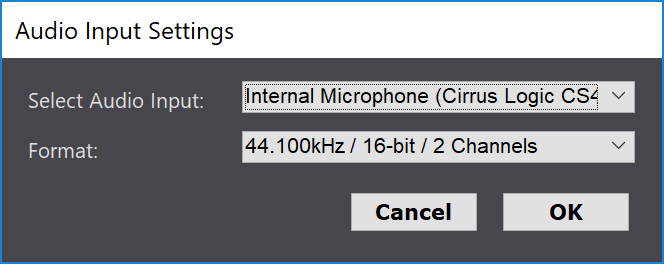
As you can see, they offer exactly the same parameters. Not only was nothing lost, if you did something in the Audio Input Settings in 2.6.1 it would screw up the Live Capture settings part so you couldn't select anything. In other words there was no purpose for this in 2.6.1.On MacOS, the "Sound Settings" button still opens the Audio Midi Setup application as it it in 2.6.1.
MOVIE SOUND OUTPUT
As it was in 2.6.1, if you have multi-channel audio movies and you assign the channels when you render the, this will be respected and the audio from those movies will play out of the proper channels on your multi channel audio interface.
AUDIO UNITS SOUND INPUT AND OUTPUT (MACOS ONLY)
All of the AU features that were in 2.6.1 remain in 3. Let me throw in here that everything you could do with multi-channel sound playback in 2.6.1 -- and a whole lot more -- can be accomplished if you use the AUAudioFilePlayer and other audio unit plugins to route the sound.
SOUND PLAYER SOUND OUTPUT
The only place the Sound Output Settings had an impact was on the Sound Player. In Windows 2.6.1 if you selected the Sound Output Settings item from the menu you saw this
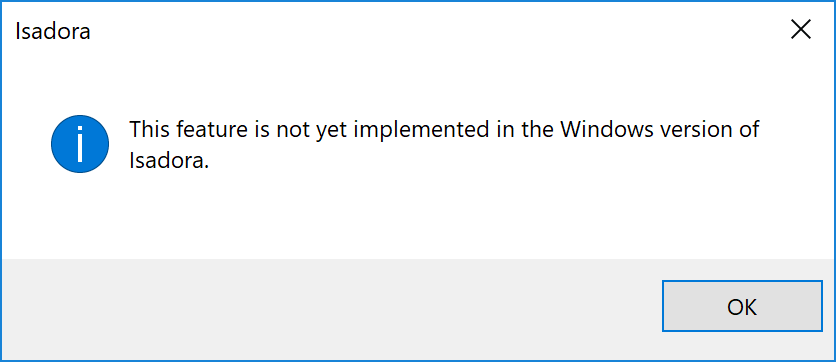
So you most certainly didn't lose anything there.But it is true that you lost something on MacOS in terms of the Sound Output Setup. In anticipation of getting a universally improved sound output in Isadora, I felt it was important to go to a cross-platform sound library that would be the same on MacOS and Windows. While Jacques may not thing that SoLoud is very good, in terms of the core functionality of getting sound out of the program, it does the job well. It's lightweight, low-latency and works exactly the same on MacOS and Windows. Having SoLoud in place paves the road for somethig I desperately wanted to get into this release: VST support for both MacOS and Windows. Unfortunately, to do VST fully is a massive task of its own, that we just couldn't do it without more months of delay.
I won't promise VST for the first point release, but I will promise multi-channel output from the Sound Player again. The main task here is to write a decent sounding sample-rate converter; the actual multi-channel output is fairly easy once that's done.
But what is possible in the short term: if this is an urgent issue for people, I can look into reinstating the sound playback code on MacOS that was in 2.6.1. I will invesitgate this over the next few days an report back on the feasibility of this. There's a few other things that are going to bring about a 3.0.2 version relatively soon, and this could be one of the things that is in there. We just have to make sure it doesn't introduce bugs of its own.
I always take it quite personally when you guys all get upset or feel let down. I wish it we could have satisfied you all, but at a certain point we just had to say "no" to certain things and get this version out there, because it was essential that we start selling some programs. That said, I am listening to what you're saying and you can help define what's essential for the impending updates.
Sincerely,
Mark -
I agree the absence of the sound output on the player is something that is not possible. What I don't understand is why we can select different outputs in the program very easy with the Audi Device Output actors, but not with a movie player. For multichannel it is really a pity that QT is ditched. Back in the days you could make with QT5 one movie file with text, timecode, midi, 16 channel multichannel audio and video! That was really awesome. Now it is almost 2020 and were back to ehhh, how to assign a stereo audio output.....
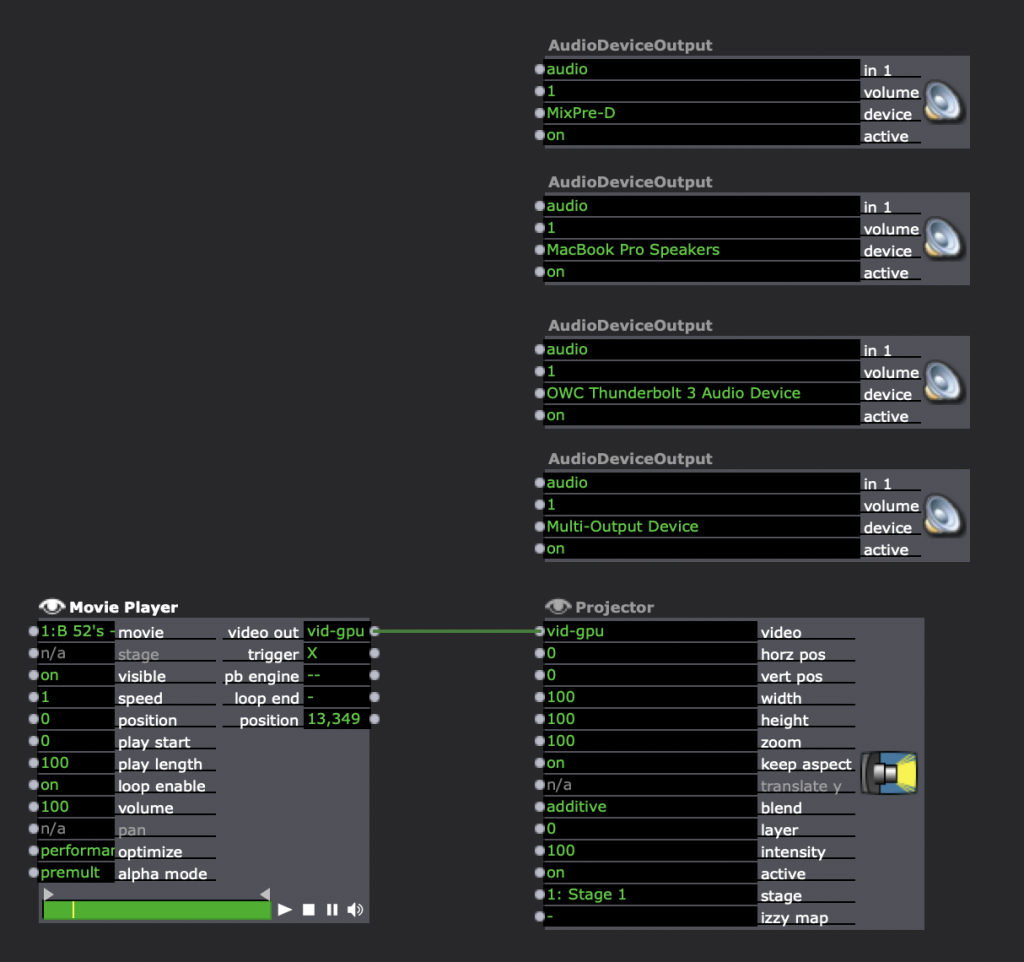
-
Everyone: I have revised my post above as I was initially under the impression that this was about Windows. Please take the time to read again.
Best Wishes,
Mark -
I have just created an experimental build that would reinstate the previous functionality on MacOS. It works as it did (I never throw code away) but now we'll have to investigate if it could lead to crashes with the threaded engine, etc. But a revision that goes back to using MacOS specific features for the MacOS version seems possible.
I will keep you updated.
Best Wishes, Mark
-
-
I made some extensive try with sound between Mac, Windows, Dante etc. here my momental results:
– Its possible to play multi tracks sound (with or without video) on V3 on MacOs. The technic is to make a multitrack wave file with "SoundFilesMerger" (free, only macos), then make a .mov file with quicktime and to play it as movie in Isadora. With a multitrack output in sound and midi config (I tried with Dante VSC and with real Motu sound card), each track go to a discrete output, as in 2.6.1
- Its not possible on Windows. I tried all the combinations between wave, .mov, M-Audio souncard, Dante, at best I have a stereo output, at worst no output at all.
I think on windows its necessary to look at ASIO implementation, it is the de facto standard on Windows, not so cool as coreAudio on macOs concerning mixed frenquecy, bit deepness and sharing of output but when you are careful, it work well and with Dante Via (unfortunately paying application) its really easy to route everything. If you play in theater equipped with Dante sound mixer its really easy to manage.
Concerning SoLoud, I made only a quick research so I cannot be so affirmative but I doesn't read anything concerning multitrack management. One of the main demand from people around me concerning Isadora is around sound routing and I think that for many situations its important to be able to route each single track to single output, be real output or software input in Ableton or Max for filtering or analyzing.
Sincerely,
Jacques
-
@jhoepffner said:
Its not possible on Windows. I tried all the combinations between wave, .mov, M-Audio souncard, Dante, at best I have a stereo output, at worst no output at all.
This goes in opposition to findings by @Fred that he posted some time ago -- though it was for Isadora 2.6.1. Did you try the techniques he described in that post? If the movies don't do multi channel output on Windows, it's a bug and we'll fix it.
Now, with regard to AIFF and WAVE audio files played by the movie player -- the experimental build solves the problem for Mac. I will have to see if it's possible to add a way to route the audio with SoLoud under Windows. I will research that in over the next few days as well.
Best Wishes,Mark
-
@mark and @jhoepffner I will re-check this media with the 7.1 audio today and let you know if it still works. I cannot imagine anything changed.
-
-
Dear All,
Here's a further update: I've reinstated the old MacOS sound behavior in the 3.0.2b1 verison which all beta testers will have right now. If you urgently need this feature, contact us by opening a ticket and we can get it to you.
But in the long run, I have a much better solution: by making a small modification in the SoLoud source code, I can route the sound to any channel on the multisound output device. ( @jhoepffner -- this is another advantage of SoLoud: I have all the source code and can improve/change it.)
So what I propose to do is to add a field to the Sound Player to allow you to specify the channel routing in the actor itself. This would be a text field so that you could enter things like
1-3, 5, 9
to route the sound to channels 1, 2, 3, 5 and 9.
You could then use this input change the routing interactively if you wanted.
I have tested this and it works well for stereo sounds. What I have not yet tested is, for example, a four channel sound and a routing like the above, though I think it will work OK. I'll do that teest in the coming week.
This would give us a very flexible, cross-platform solution to routing sound.
Comments?
Best Wishes,
Mark -
@mark of course things got out of hand and I can actually test tomorrow. I have a few other tests I want to do with video playback as well. The proposed changes to soloud giving routable audio sound pretty great (but I'm assuming this is only for audio files not for the audio from a movie player?).
Sorry things are getting pushed before the summer break. I have a little list for Isadora for checking to reproduce some errors I found (unless they are just for me).
-
@fred said:
(but I'm assuming this is only for audio files not for the audio from a movie player?).
This should also be possible under Windows; I saw some stuff in the API for Media Foundation that seemed to allow this with relative ease, but I have to find that again and refresh my memory. In AVFoundation, it is a much bigger job: Apple engineers told me some time ago that "we will never support the sound routing capabilities of QuickTime in AVFoundation." (Thanks Apple!) What's required is to build an entire Audio Units graph that intercepts the sound coming from the movie and then routes it to the proper channels using an AUMatrixMixer. Not a small task I'm afraid.
Still, I'm listening to all of you about the importance of audio. Let's keep talking and we can see what's possible to get on the roadmap for the 3.1 release we plan for the August Werkstatt.
Best Wishes,
Mark -
@mark ok thats tough. I'll get some tests done tomorrow.
-
Dear Mark,
it sounds very good. Is also then a possibility to record sound as a sound file and reimport in Isadora as it is possible for video it would be great.
Thanks for all
best
Jean-François
-
@jfg said:
it sounds very good. Is also then a possibility to record sound as a sound file and reimport in Isadora as it is possible for video it would be great.
Right now it's possible to create sound-only movie files with a setup like this (if that's of any interest to you):
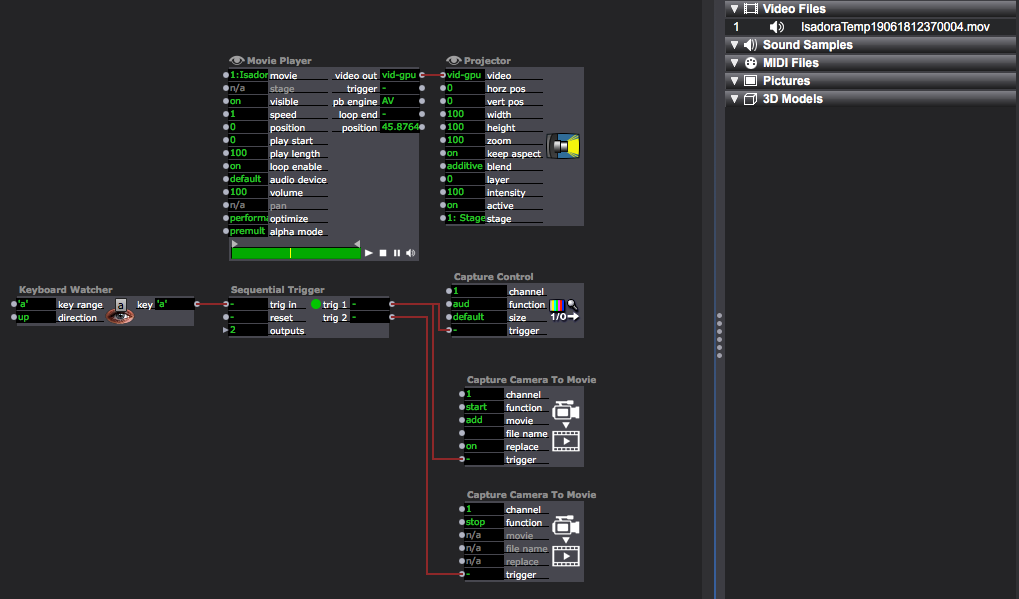
-
I know but it is not possible to use directly the AU actors on the movie files. It is only possible over soundflower and I am not sure how many ressources more it is using.
e.g.
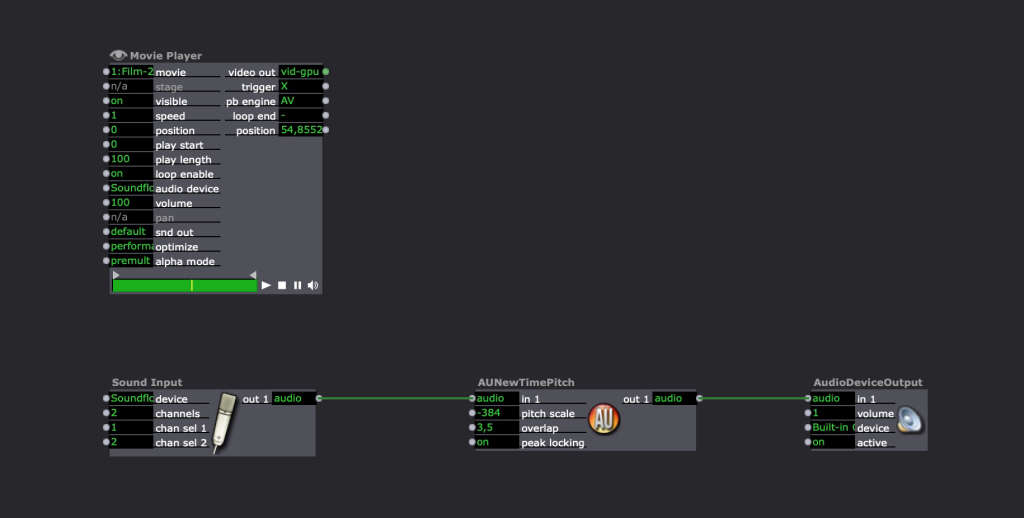
-
Soundflower is pretty lightweight I think. It's pretty much moving as much data around as an AU module would.
Best,
M -
@jhoepffner @mark I can confirm my hap AVI files with 8 channels of audio play back properly with Isadora 3.01, that is the 8 discreet tracks are sent out 8 different outputs of my sound card. This does require that you configure your windows audio output to be 7.1 (so you need a sound card with at least 8 outputs. Windows does not give you much control over this, but I use an RME interface and from there I can re-route outputs wherever I like. I cannot mix channel mappings on the fly unless I use the RME control software and use midi or OSC to trigger snapshots, (you can even do real time mixing) so I can kind of solve these problems easily, but it does require creating the multichannel files first. I did this with virtual dub. I took a 7.1 wav file and muxed it (not recompressing video) with the exported video files. It was super fast, just really a data copy.
@Juriaan This wokrs fine on mac as well (with proress files and mulitchannel audio). It may be a fast fix for your 48k wav problem as the files I play and my audio system clock are locked to 48k (even slaving via workdclock if need be). It takes a bit of planning but muxing to a very small (like 64 px * 64 px) video file is fast and an easy way to get solid multichannel control. Definately far from these functions being native in Isadora.
Fred
-
Dear @Fred
Thank you for verifying that the multichannel sound output worked as you expected.
@DusX – take note of the fact that it seems to require 8 channels of output, and that a four-channel device may not work. I see that the Windows setup allows for stereo, 5.1 and 7.1. Will investigate more when I have the four channel device you suggested.
Best Wishes,
Mark -
Just an update to record, that I have multi-channel audio output working on my 4 channel Roland Rubix 24.
I have to set the device (configure) to Quadraphonic, and prepare the Video media in 5.1, where channels 5+6 are the rear channels that get mapped to 3+4 in the Roland (due to: L,R,C,Sub,SL,SR ordering of the channels)
Windows speaker test, however; plays Center and Sub to the 3+4 outputs. So the assignment of these channels is key.